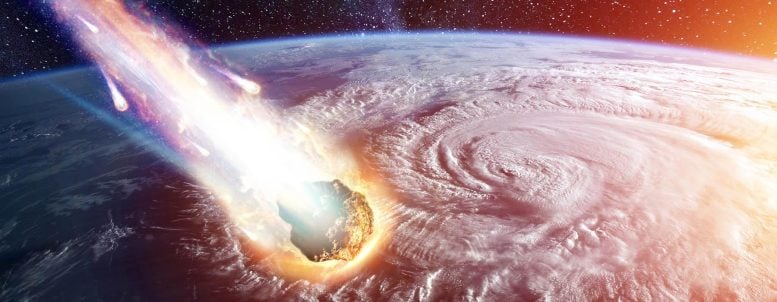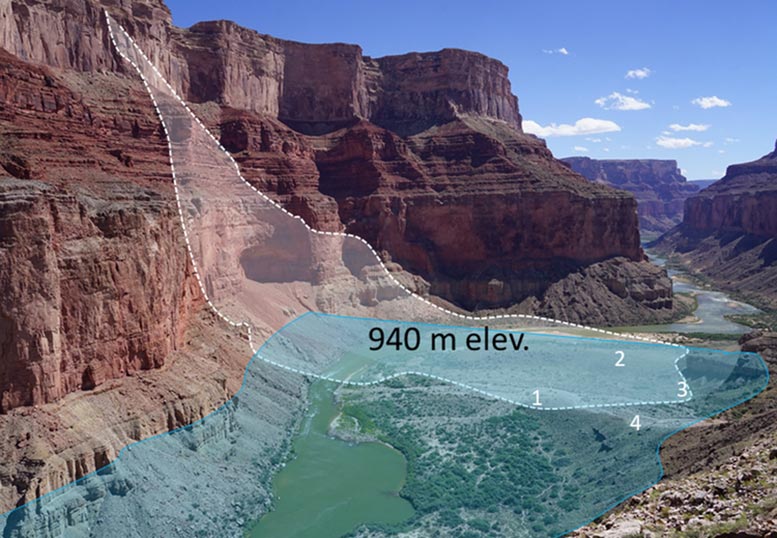
A remarkable coincidence occurred 56,000 years ago, when the impact that created Meteor Crater triggered both a landslide-dammed lake and a paleolake formation in the Grand Canyon.
Earth’s ancient past often reads like a mystery novel, and a recent study published in Geology reveals one of its most intriguing chapters. Authored by University of New Mexico Distinguished Professors Emeritus Karl Karlstrom and Laurie Crossey, along with an international team of researchers, the paper uncovers a surprising connection between two of the Southwest’s most iconic geological features: the Grand Canyon and Meteor Crater.
The research centers on a remarkable alignment in the ages of two major events. Around 56,000 years ago, a meteor struck the Earth, and roughly at the same time, a massive landslide formed a natural dam in the Grand Canyon, temporarily halting the flow of the Colorado River and creating an ancient lake. Alongside this geological investigation, the paper also traces the efforts of multiple generations of scientists and showcases recent breakthroughs in dating techniques that helped piece the story together.
“It would have required a ten-times bigger flood level than any flood that has happened in the past several thousand years. Or maybe they are very old deposits left as the river carved down, or maybe they floated in from a paleolake caused by a downstream lava dam or landslide dam? We needed to know the age of the cave deposits,” said Karlstrom.

In the mid-1960s, Karl Karlstrom’s father, Thor, participated in a collaborative geology and archaeology project that took him into one of the Grand Canyon’s caves. During the expedition, the team uncovered remains of animals that once lived in the region but have since disappeared, including the California condor and Harrington’s mountain goat. They also discovered split twig figurines, crafted between 3,000 and 4,000 years ago by the ancestors of Indigenous communities still residing near the canyon today.
Among the finds was a piece of driftwood that initially tested as being more than 35,000 years old, a result that approached the upper limits of radiocarbon dating available at the time. That estimate was revised in 1984 to 43,500 years. Now, with advanced techniques and data from laboratories in New Zealand and Australia, the new study reports an updated and more precise age of 56,000 years.
Piecing Together Clues From Labs to Caves
The coauthor team involved Chris Bastien, who serendipitously was working on the Stanton’s driftwood collections housed at the University of Arizona Tree Ring laboratory, and David Kring, who was science coordinator for Meteor Crater and who had been working to recalculate Meteor Crater ages (53,000- 63,000 years old by different methods). When co-author Jonathan Palmer from the Australian lab was on a road trip to the USA, he visited both Meteor Crater and Bastien at the UA lab and noted the striking coincidence of ages that set this paper in motion.
“From numerous research trips, Karl and I knew of other high-accessible caves that had both driftwood and sediment that could be dated,” said Crossey.

They sent another driftwood sample to the Australia and New Zealand labs, and sediment samples to Tammy Rittenour at Utah State University (USU). Having two dating methods was a key part of this study. Both came back with statistically indistinguishable 55,600-year-old dates.
In the 1980’s Richard Hereford of the USGS in Flagstaff had proposed that there was a rockslide near Nankoweap Canyon at RM 52, about 22 RM downstream of Stanton’s Cave, that might have formed a dam and a paleolake that backed up water and that allowed driftwood to float into Stanton’s cave. This hypothesis now came back into the limelight with the additional 56,000-year-old samples from different caves high above the river. Grand Canyon caver Jason Ballensky had even seen beaver tracks way up and way back in Vasey’s Paradise caves, in a place that would be inaccessible to beavers.
Data Supporting a Temporary Lake and a Massive Dam
Their combined results, of how deep and long the paleolake is thought to have been, are shown in the Colorado River Profile graph. Findings reported in the Geology paper are as follows.
- Driftwood and sediment are found in many caves as high as 940 m elevation, such that the lake backed up water above Lees Ferry, where boating trips launch– the paleolake hypothesis seemed to be “holding water.”
- There are two places where the reddish chaotic dam material at Nankoweap Canyon is overlain by rounded far-traveled and identifiable river cobbles, suggesting there was a dam there that got overtopped and deeply eroded, likely within less than 1000 years, based on analogies to modern concrete dams are filling up with sediment. So the landslide dam idea was “falling together.”
Was the Meteor Crater impact enough to cause such a landslide? Kring has written about the physics of this and other impacts and has calculated that the impact would have set off a magnitude 5.4 earthquake (or even M6 using different assumptions) and that the shock wave would still have been ~M3.5 after traveling (in seconds) the 100 mile distance to Grand Canyon. So, the impact could have “shaken loose” the steep cliffs of Grand Canyon that were “waiting and ready to go,” as shown by numerous rock falls that happen in Grand Canyon.
“The team put together these arguments without claiming we have final proof; there are other possibilities, such as a random rockfall or local earthquake within a thousand years of the Meteor Crater impact that could have happened independently,” explained Karlstrom. “Nevertheless, the meteorite impact, the massive landslide, the lake deposits, and the driftwood high above river level are all rare and unusual occurrences. The mean of dates from them converges into a narrow window of time at 55,600 ± 1,300 years ago which gives credence to the hypothesis that they were causally related.”
Reference: “Grand Canyon landslide-dam and paleolake triggered by the Meteor Crater impact at 56 ka” by K.E. Karlstrom, C.H. Baisan, D.A. Kring, R. Hereford, C. Turney, A. Hogg, L.M. Norman, P. O’Brien, J.G. Palmer, T.M. Rittenour, J. Ballensky and L.J. Crossey, 15 July 2025, Geology.
DOI: 10.1130/G53571.1
Never miss a breakthrough: Join the SciTechDaily newsletter.